
A soil borne fungus found throughout all cotton growing areas

A soil borne fungus that is easily found in soils throughout the state but causes disease only when soils are relatively cold and wet

A soil borne fungus that enters the roots and grows into the vascular system of the plant

A soil inhabiting fungus that causes a vascular wilt disease

Meloidogyne incognita, infects cotton and many other plants

A new race of Fusarium oxysporum f. sp. vasinfectum (FOV), the Fusarium wilt pathogen of cotton, has become problematic in the San Joaquin Valley of California. Known as Fusarium oxysporum f. sp. vasinfectum race 4 (FOV 4), it is an early season disease on cotton. Fusarium wilt disease has never been problematic in Arizona and was not detected in 2012, but surveys continue in 2013.

Symptoms in seedlings at the 1-2 leaf stage are wilt and/or defoliation and collapse. Severely affected plants die. In plants with 4-10 nodes, symptoms may include pale yellow to tan patches on the lower leaves (photo 2).

When the root and lower stem are cut diagonally, dark brown discoloration is observed in the vascular tissue (photo 3), and plants may be partially or totally defoliated.
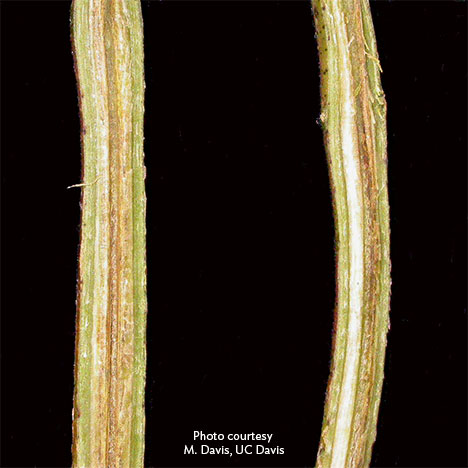
Symptoms in plants with 4-10 nodes or older are very similar to those of Verticillium wilt.
Several races of FOV occur worldwide, and they infect only cotton. Some races depend on co-infection with root-knot nematode to be problematic, but race 4 does not.
FOV is introduced into fields in soil, plant debris and contaminated seed. It moves within fields in soil and water.
FOV increases in the soil when infected plants are plowed down. FOV 4 can be seed borne,
and infected seed is a likely means of distribution of the pathogen to new areas.
Disease severity depends on amount of FOV 4 in the soil and cotton variety.
Varietal susceptibility varies widely in Pima cotton, but upland varieties are susceptible also.
FOV 4 can be prevented by planting tolerant varieties of cotton; using seed produced where FOV 4 does not occur;
cleaning equipment of any kind (including shoes) that may have been used in an infested field and carry soil from one field to another.
FOV 4 also survives on many other plants without causing disease, including rotation crops and weeds,
so movement of equipment from California should be carefully monitored.
The Root-knot nematode, Meloidogyne incognita, infects cotton and many other plants. This nematode is widespread in Arizona and is usually found in sandy or sandy loam soils. It is an obligate parasite that must complete its life cycle in a plant host, but eggs are persistent and can remain inactive in the absence of a host and/or in fallow fields for months or years. It is most active in the summer when soil temperatures are warm.
As M. incognita larvae enter the plant root, feed, and mature, the surrounding cells of the plant root increase in size and divide causing swellings (galls) on the roots.
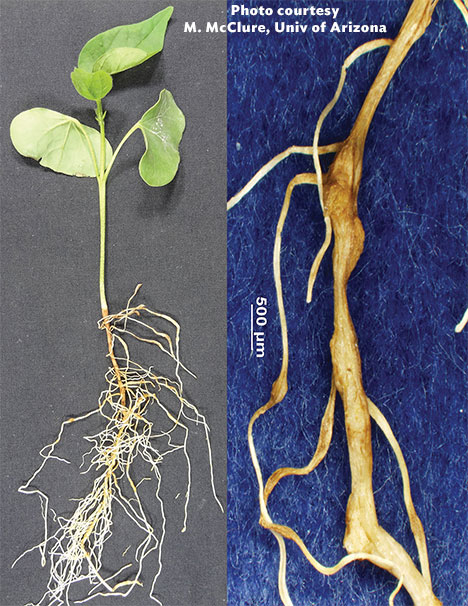
In cotton, these swellings are usually small and often very inconspicuous. Plants may be heavily infected even though swellings are not easily visible (photo 1). Once cotton plants are infected, the flow of nutrients and water is restricted. Severely infected young plants are often stunted and chlorotic. Infected mature plants do not die, but yields are reduced.
Because of the wide host range of root-knot nematode, control is difficult. Sorghum, corn, melons, watermelon, peppers and beans, among many other crops, are all hosts. Rotations to alfalfa and oats, which are not hosts, are effective, especially in multiple year rotations.
Pre-plant soil fumigation with 1,3 Dichloropropene is also effective in reducing early infections. Fumigation is recommended if greater than 0.5 juveniles/cc soil are detectable.
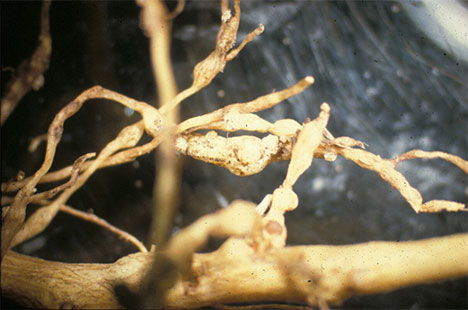
Verticillium wilt of cotton is caused by Verticillium dahliae, a soil borne fungus that enters the roots and grows into the vascular system of the plant. It does not cause root rot. Early symptoms appear as stunting and chlorotic areas in lower leaves (photo 1).

Chlorotic and necrotic areas may be observed on leaves (photo 2).
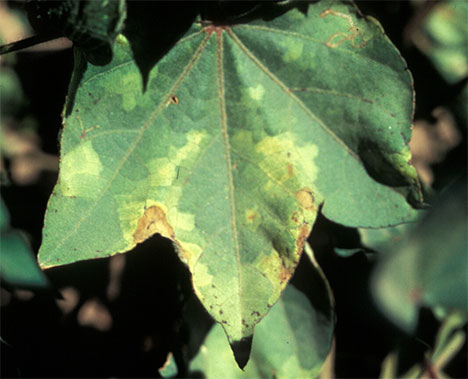
Brown flecking discoloration of the vascular tissue (photo 3) is visible in a diagonal cut of the root and lower stem, but this may be faint in younger plants.
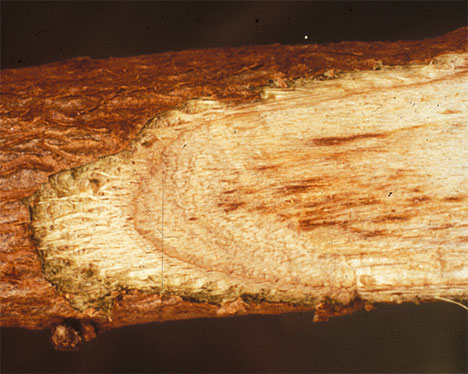
Symptoms usually appear in late August and September, and may be more pronounced in years when early season temperatures (May to early June) are lower than usual or in very susceptible varieties. If plants wilt and die, foliar symptoms may be confused with those of cotton (Texas) root rot, but plants infected with Verticillium alone do not have rotten roots. Symptoms of Verticillium wilt of cotton are very similar to those of Fusarium wilt, but to date no races of Fusarium wilt have been problematic in cotton in Arizona.
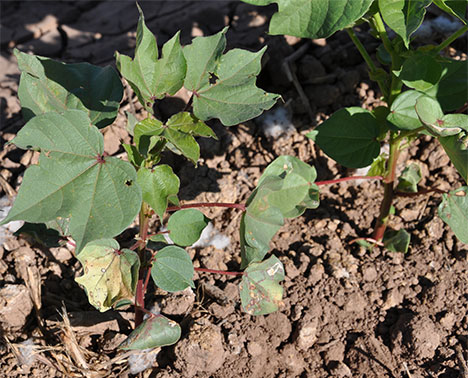
V. dahliae survives in the soil for long periods of time as microsclerotia, tiny survival structures produced in the plant tissue. Upland (G. hirsutum) varieties differ widely in susceptibilty, and less susceptible varieties should be planted in problematic fields. Pima cotton (Gossypium barbadense) is tolerant. Rotation to alfalfa and grains may reduce the number of microsclerotia in the soil, but does not eliminate disease. There are no chemical control measures available.
Seedling disease of cotton in Arizona is caused primarily by Rhizoctonia solani and to a lesser extent by Thielaviopsis basicola.
Thielaviopsis is a soil borne fungus that is found in soils throughout the state but causes disease only when soils are relatively cold and wet. It causes a dark colored root rot that also gives the disease the name "Black root rot" (photo 1).
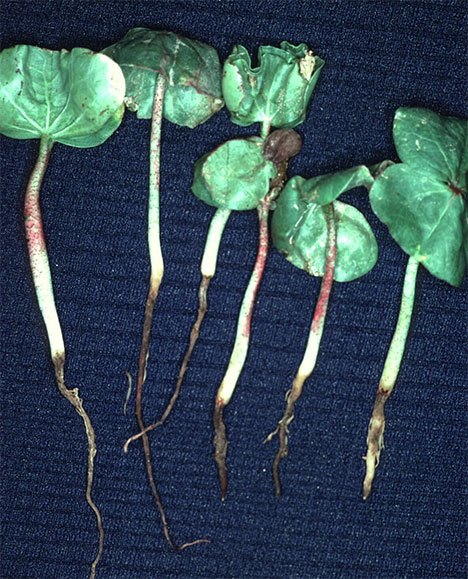
Planting into warm soils is the best way to avoid disease, but seed treatments are recommended for fields with a history of disease. Few fungicides are active against this fungus, and an added value seed treatment may be necessary.
Seedling disease of cotton in Arizona is caused primarily by Rhizoctonia solani and to a lesser extent by Thielaviopsis basicola.
Rhizoctonia is a soil borne fungus found throughout all cotton growing areas in Arizona. It commonly causes post emergent damping-off or collapse of seedlings when plant growth is slowed by low soil temperatures, residual herbicide phytotoxicity, planting too deep, poor seed vigor or crusting. Infected seedlings may have sunken reddish to brown colored lesions on the upper root (photo 1), or roots may be soft and darkened with a noticeable constriction at the soil line.
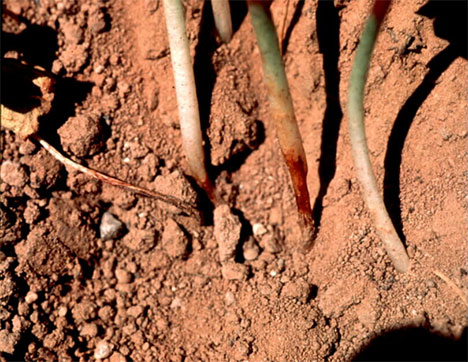
Fungicide treatment of seed reduces disease, but the best prevention is planting into soils when temperatures are favorable for fast germination and using high quality seed. Fields with a history of severe disease should be rotated out of cotton.

A soil borne fungus found throughout all cotton growing areas

A soil borne fungus that is easily found in soils throughout the state but causes disease only when soils are relatively cold and wet

A soil borne fungus that enters the roots and grows into the vascular system of the plant

A soil inhabiting fungus that causes a vascular wilt disease

Meloidogyne incognita, infects cotton and many other plants